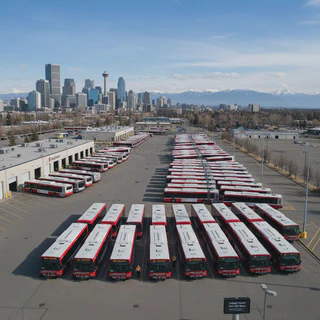Calgary Transit Vehicle and Fleet Sizing Project
 Image credit: City of Calgary
Image credit: City of Calgary
Table of Contents
Overview
CLIENT
City of Calgary, Calgary Transit the municipal public transport agency
LOCATION
Calgary, Alberta, Canada
Role
Designer, Planner
Markets
Transit & Rail
Transportation Market
Solutions
Transit Planning
Fleet Size
Vehicle Size
Planning
Crowding
Sustainability
Transportation Services
Regions
Calgary Metropolitan Region
Our Client’s Challenge
Calgary is a city in the Canadian province of Alberta. As of 2021, it had a population of 1,306,784 within the city proper and 1,481,806 in the metropolitan area, making it the third-largest city and fifth-largest metropolitan region in Canada.
During the COVID-19 pandemic, Calgary Transit, like many other agencies, began operating buses at reduced capacities to allow passengers to maintain physical distance and minimize the risk of virus transmission. This operational shift introduced a new consideration in transit planning, i.e., the cost of crowding, or the perceived inconvenience experienced by passengers when vehicle occupancy is limited.
The city sought to understand how these perceived crowding costs could affect operational decisions such as fleet sizing, vehicle allocation for each route, seating configuration, and overall service levels.
This project focused on several key objectives:
- Critical Assessment: Evaluate how crowding costs, arising from pandemic-related constraints or general passenger discomfort, impact transit planning decisions.
- Scenario Development: Define specifications and characteristics for different cases involving available fleet size, vehicle capacity, and service levels.
- Data-Driven operations planning: Apply analytical and data-driven methods to conduct corridor-level studies and develop capital investment strategies for each transit route.
- Stakeholder Reporting: Present results and strategic recommendations to stakeholders.
 Figure: Project Pipeline Based on Proposed Data-Driven Framework.
Figure: Project Pipeline Based on Proposed Data-Driven Framework.
Our Solution
In partnership with the Government of Alberta, the City of Calgary, and Calgary Transit, our project developed a replicable and innovative analytical framework that the city can easily use to determine the optimal operations planning strategy for each local bus route.
 Figure: Different seating configurations can be designed for bus interiors.
Figure: Different seating configurations can be designed for bus interiors.
Outcomes
- Scalable Data-Driven Framework: Developed a replicable, data-driven framework for determining optimal fleet size, vehicle size, and service level.
- Near-Optimal Solutions: Designed advanced models capable of producing high-quality solutions with minimal computational requirements.
- Sustainability Benefits: Reduced costs for both users and the transit agency, improved passenger experience and overall well-being, and maintained high service performance standards.
Recommendations and Policy Implications
The findings have several important implications for transit planning and policy:
- Vehicle Capacity Optimization: Optimal vehicle capacity is linked to the average passenger trip length and the square root of crowding-discomfort costs, particularly when perceived crowding increases linearly with the load factor.
- Service Flexibility: When the transit agency has full flexibility in setting service levels and vehicle types, most suburban areas can be effectively served with on-demand transit using smaller vehicles, especially during off-peak hours.
- Low Perceived Crowding Costs: When perceived crowding costs are relatively low (below $2.5 per hour per passenger), small vehicles such as minivans provide a cost-effective and efficient alternative for serving suburban demand.
- Autonomous Vehicle Integration: In scenarios involving autonomous vehicles, where driver-related labor costs are eliminated, deploying smaller vehicles at higher frequencies consistently emerges as a near-optimal strategy.